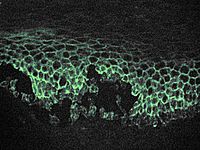
Photo from wikipedia
Familial benign chronic pemphigus or Hailey-Hailey disease (HHD) is an autosomal dominant genodermatosis with complete penetrance that was initially described by dermatologists and brothers Howard and Hugh Hailey.1 This disorder… Click to show full abstract
Familial benign chronic pemphigus or Hailey-Hailey disease (HHD) is an autosomal dominant genodermatosis with complete penetrance that was initially described by dermatologists and brothers Howard and Hugh Hailey.1 This disorder results from mutations in the ATP2C1 gene on chromosome 3q21, which encodes the Golgi-associated Ca2+ ATPase. Mutations in this gene lead to abnormal intracellular Ca2+ signaling leading to impaired processing of junctional proteins needed for cell-cell adhesion. The generalized or disseminated form of HHD is rarely documented, but appears to typically be induced by microbial colonization and secondary infections. In particular, Staphylococcal infection can potentiate acantholysis and may lead to severe widespread blistering.2, 3, 4, 5 Other articles suggest that the generalized condition can be triggered by a Koebner-like reaction or even sensitivity to nonsteroidal anti-inflammatory drugs.3 Treatment for generalized HHD varies.2, 3, 4, 5 Oral corticosteroids are most commonly recommended for treatment; however, alternative interventions include oral retinoids, including etretinate,4 cyclosporine, methotrexate, dapsone, and topical tacrolimus.3 In nongeneralized HHD, there are a few published case reports of HHD treated successfully with low-dose naltrexone (LDN).6, 7, 8, 9
Journal Title: JAAD Case Reports
Year Published: 2018
Link to full text (if available)
Share on Social Media: Sign Up to like & get
recommendations!